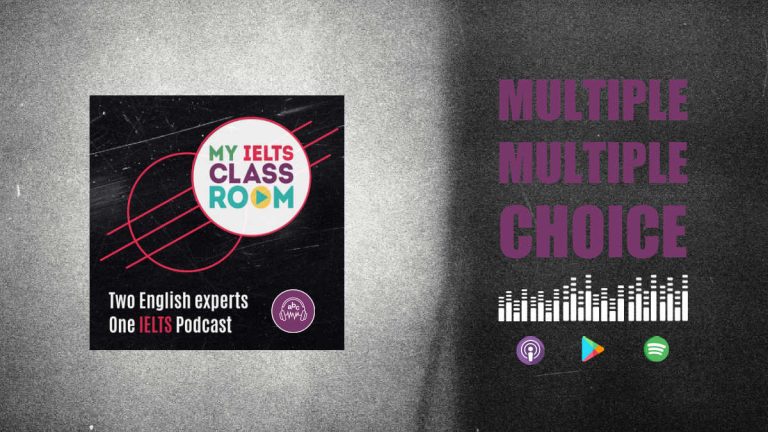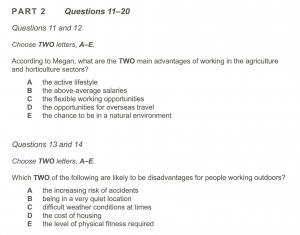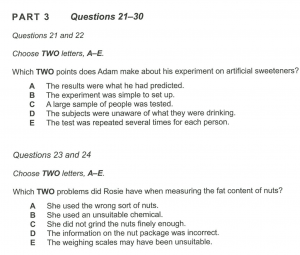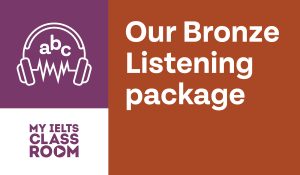
IELTS Listening Multiple Multiple Choice
In the IELTS listening exam, there are two types of multiple choice questions: those where you are given 3 possible answers and asked to choose ONE, and those where you are given 5 or 7 possible answers and are asked to choose TWO or THREE. Today, we are going to look at the second type of question or, as I like to call them, IELTS listening multiple multiple choice questions.
This is an interactive episode so please have a pen and piece of paper ready so that you can join in the activities.
Below, you can find a summary of the episode, which includes all of the links to useful materials and the times of each part of the discussion (so you can go directly to the part you want to listen to). You can also find every episode of the podcast here 🚀
- Subscribe to My IELTS Classroom podcast on Apple podcasts here
- Subscribe to My IELTS Classroom on Google podcasts here
- Become a Patreon to gain access to extra BONUS episodes here
IELTS Listening Multiple Multiple Choice: The Basic Facts
Let’s start as always with some basic facts about this type of listening question:
- You will be given a multiple-choice question, but rather than being asked to choose ONE answers, you will be asked to select 2 or 3
- If you are asked to select 2 answers, you will be given 5 options.
- If you are asked to select 3 answers, you will be given 7 options.
- Just like multiple choice, you will often hear ALL of the options discussed.
- Just like multiple choice, you will NOT hear the items discussed in the same order as they are given to you on the paper (i.e. you may hear option E discussed first, and then option B, and then option C)
- Also, just like multiple choice, you will probably hear paraphrasing and synonyms for the options.
- It does NOT matter which order you write your answers on the answer sheet. So, if you are answering questions 19 and 20, and you think that the correct answers are A and B, you can write A for 19 and B for 20, OR you can write B for 19 and A for 20, What you must NEVER do is write more than one answer in one box.
IELTS Listening Multiple Multiple Choice: 2 Steps to finding the answer
Step One: Learn to listen actively
The first skill that you need to develop to find the answers in an IELTS listening multiple multiple choice is identifying the “key word” in the question so that you know what you are listening for. Take this question for example. What do you think is the most important word in this question?

The answer is 100% the word “new”. Why? Well, remember that we will probably hear all of the options discussed, so simply hearing “swimming” or “cycling” will not be enough for you to identify the answer. What you will need to do is listen carefully for any language that makes it clear that the after-school lessons are NEW this year.
For example, you may hear a phrase like “acting has been added to the curriculum” or “we have recently added piano lessons”. Obviously, you cannot predict the phrase that you will hear, but this is what you should be focussing on as you listen.
Also, it is very likely that you will be told that the distractors (i.e. the options that are NOT the answers) are NOT new. For example, you may hear a phrase like “swimming has always been our most popular course”. or “the waiting list for the theatre sound and lighting course was very long last year, so sign up soon”. Again, you can use this information to eliminate incorrect answers.
Plus, you may find that for some items we are just not told if they are new or not. These are what I like to call “not given” options. Again, only ever select an option as an answer if you have heard a word or phrase that makes it clear that the lesson is NEW.
Step Two: Learn to recognise paraphrase
Questions 19 and 20 above should be relatively easy to answer. How do I know? Well, because the five options you have to choose from are all single words or proper nouns. That means that it is unlikely that you will hear any synonyms or paraphrases in the recording.
However, not all IELTS listening multiple multiple choice questions are like this. Most of the time the possible answers will be longer phrases, and when this happens it is VERY likely that you will have to listen for synonyms to identify which options are being discussed.
Take questions 11 and 12 below. In the recording, option A (active lifestyle) is discussed in the recording with this phrase “not sitting all day looking at a screen” while option C (flexible working conditions) is signalled by the phrase “opportunities for those who don’t want to be stuck with a 40-hour week”

Therefore, in order to answer questions questions it is important that you can first identify which option is being discussed (i.e. recognise paraphrasing) and then listening actively to see if it is an answer or not. For questions 11 and 12, that will be listening to check if the option is a MAIN ADVANTAGE, and for questions 13 and 14, that will mean listening to see if it is a DISADVANTAGE.
IELTS Listening Multiple Multiple Choice in Part 3
The two steps that we discussed above are still useful in Speaking Part 3, but you should be aware that IELTS listening multiple multiple choice questions do differ slightly here.
Firstly, as the language is more complex here and you are dealing with two (or three) speakers and not one, you may find that NOT all of the options are discussed.
You may also find it more difficult to match the paraphrases with the options. This is because the options may no longer be a word for word paraphrase of what you hear, but a SUMMARY.

Also, as this is Part 3, you can expect some questions to focus on agreement or emotions. if you have never come across this concept before, I would recommend that you listen to this episode, where Nick and I explain the importance to listening for attitude and how you can train to do so.
The final, and probably the most important, difference is speed.
The options being discussed change much more quickly that in Part 2, so you may find that the two answers are given in successive sentences.
That makes it all the more important that you are able to identify the paraphrasing of the option being discussed as you may only have one sentence to do so.
In the lesson, we will look at the following questions to see how IELTS listening multiple multiple choice questions differ, and also to discuss how the exam writers often use opposite to confuse students here.

Would you like expert help you improving your Listening?
We offer a 5-day intensive course for IELTS test-takers every month that covers all aspects of listening, from how to approach every type of question, to how to use key words to follow a lecture, and avoid the distractors in Multiple Choice questions. Even better, with every course having no more than 8 students and being run by an ex-examiner, you will be getting personalised advice that is guaranteed to help you to improve your score.
Find out more about the course and how it can help you hit your target score here.

